Morton's Neuroma
Do You Have Tingling in Your Toes?
Morton’s neuroma is pain, numbness, or tingling in the forefoot, especially between the 3rd and 4th toes. The pain is due to the thickening of the nerve that supplies the sensation to the area between the toes.
Other names for the condition are Morton’s metatarsalgia, Morton’s neuralgia, plantar neuroma, and intermetatarsal neuroma.
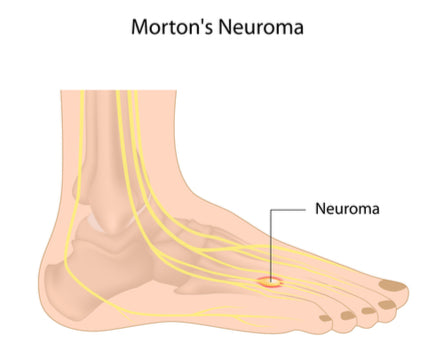
Tingling or numbness in your toes? It could be Morton's Neuroma.
Morton's Neuroma is a common condition in the forefoot and is often described as a burning, aching, or shooting pain.
We Recommend
-
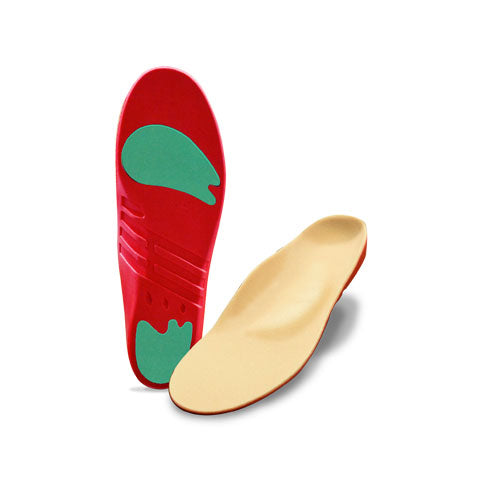
Pressure Relief with Met Pad
$39.99
-
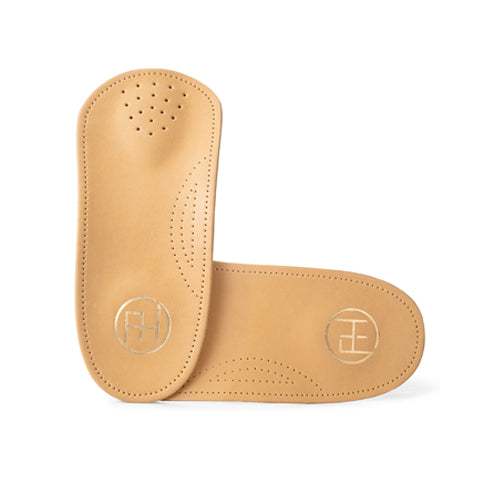
Everyday 3/4
$29.95
-
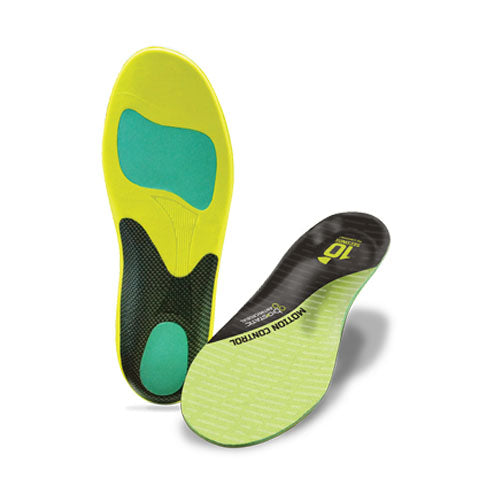
Motion Control
$49.99
-
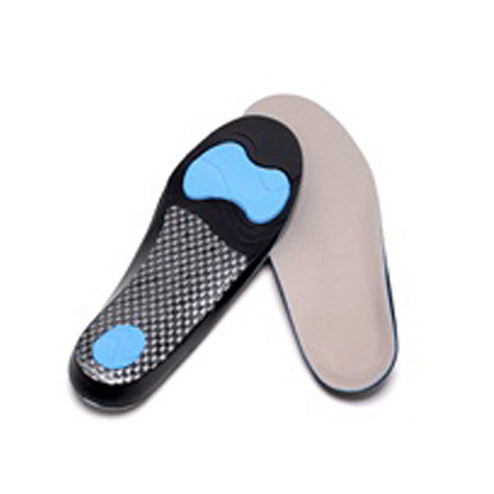
Ultra Arch
$49.95
What Is Morton’s Neuroma?
Morton’s neuroma is a sharp, burning pain or numbness and tingling between two toes which can extend outwards or involve the whole side of your foot. The pain is most often described as a burning discomfort in the forefoot however aching or sudden shooting pain in the forefoot is also common.
The pain in the forefoot can be intermittent at first but it may become more frequent as time progresses. It often becomes worse when wearing shoes or with activity and is usually aggravated by squeezing the foot.
The condition most commonly occurs in women (it is estimated to occur in women 8-10 times more often than men). It is termed Morton’s neuroma when it occurs between the third and fourth toes; if the condition appears between other toes it is just called neuroma.
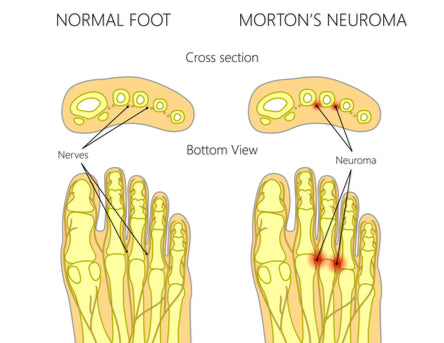
Morton’s Neuroma is a sharp, burning pain or numbness and tingling between two toes which can extend outwards or involve the whole side of your foot.
What Are The Symptoms Of Morton’s Neuroma?
If you are experiencing the following symptoms you may have Morton’s neuroma.
- Tingling, burning, or numbness in the toes
- Pain in the ball of the foot
- A feeling as though you are standing on a pebble or bunched up sock in your shoe
The symptoms of morton’s neuroma often follow a progressive pattern:
It is always best to consult a doctor to confirm that you have morton’s neuroma and move on to treatment.
What Causes Morton’s Neuroma?
Morton's neuroma seems to occur in response to irritation, pressure or injury to one of the nerves that lead to your toes. Constant irritation/pressure causes the nerve to thicken in response and cause Morton’s neuroma to develop.
The most common cause of this condition is wearing narrow or high-heeled shoes that force the toe into a tapered toe box. Extensive wear of tight fitting or high heeled shoes adds pressure to the nerves and puts you at risk of developing Morton’s neuroma.
High impact activities (such as running or jogging) which put pressure on the ligament can also cause the nerve to thicken over time. So can sports that require tight fitting shoes, such as skiing.
Deformities such as hammer toes, bunions, and flat feet can also cause the ligament to press on the nerve, adding pressure and putting you at risk of developing Morton’s neuroma.
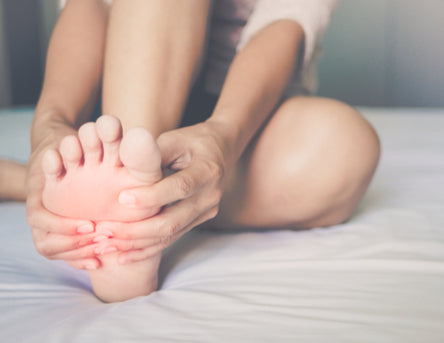
Tight fitting shoes can cuase irritation to the nerve between the toes. Deformities such as hammer toes, bunions, and flat feet can also cause the ligament to press on the nerve.
Does Morton’s Neuroma Go Away?
Once formed, Morton’s neuroma will not go away on its own.
That said, there are ways that the pain caused by it can improve or disappear. The earlier you receive treatment for Morton’s neuroma, the higher your chances of pain resolving.
In more advanced cases, the pain may return in episodes if you have been on your feet for a long period of time or continue to wear tight-fitting shoes. Repeated treatments or surgery may be required in these instances.
What Can I Do To Treat Morton’s Neuroma
If caught early, the treatment for Morton’s neuroma is quite simple. Once developed you will want to modify your activity until the condition improves. The condition can be very painful as it progresses, so here are a few home remedies to mitigate pain and ease recovery.
Take anti-inflammatory medications
Over-the-counter nonsteroidal anti-inflammatory medications, such as ibuprofen (Advil, Motrin IB, others) can reduce swelling and relieve pain.
Change your footwear
Morton’s neuroma can usually be avoided by wearing shoes that allow adequate space for the foot and toes. It is important to pay attention to your footwear and switch to shoes with a wide, oblique, mitten-shaped toe box. Shoes with rocker soles can also help relieve pressure in the forefoot.
Ice and stretch
Regular ice massages can reduce swelling and pain. By using an ice pack or freezing a water-filled paper cup or plastic water bottle, you can gently massage the affected areas to reduce swelling and temporarily lessen pain.
Over the counter insoles or custom shoe inserts
Certain types of arch supports can help reduce the pressure on the nerve, especially an arch support with a metatarsal pad. Browse our selection of insoles with met pads to add support to your foot and reduce your risk of developing Morton’s neuroma. These insoles can also help to relieve the pain caused by Morton’s Neuroma:
- 10 Seconds Pressure Relief with Met Pad Insoles (best for extra cushioning for all arch types)
- 10 Seconds Ultra Arch Insoles (best for high arches)
- 10 Seconds Motion Control Insoles (best for medium/low arches)
- Birkenstock ¾ Blue FootBed Insoles
- FootHealth Everyday ¾ Insoles (best for all arch types in shoes without a removable liner)
Your doctor may recommend custom insoles for your shoes. Most likely these inserts will be designed with a metatarsal pad to help give relief from the Morton’s neuroma pain.
Injections
Some people are helped by injections to the foot to mitigate pain and ease recovery. Corticosteroid injections may be helpful in this case.
When To See A Doctor
For patients who are not responding to non-surgical treatments, surgery may be necessary.
The length and recovery period varies from patient to patient. The typical approach taken is to remove a portion of the nerve or release tissue around the nerve to relieve pressure. Although the surgery is usually successful, there is a potential for permanent numbness in the affected toes.
Prevention
Fortunately there are many good habits you can form to reduce your chances of developing Morton’s neuroma. These include:
- Warming up and stretching thoroughly before any physical activity.
- Wearing proper footwear with a wide toe box that does not add pressure to the toes.
- Maintain a healthy body weight so as to limit pressure on the foot.
- Stretch and strengthen the feet through gradual exercise.





